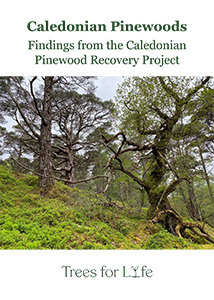Enabling the recovery of Scotland’s remnant pinewoods
About 6,000 years ago an estimated 1.5 million hectares of Scotland was covered in rich native Caledonian Pinewood. Now only about 1% of this life-supporting habitat is left, broken down into small and isolated fragments.
Scotland’s Caledonian Pinewoods are made up of ‘wild trees’. These are Scots pines and other native species whose ancestry stretches back to the last ice age. This globally-unique habitat can only be found in the Scottish Highlands. The pinewoods provide refuge for an abundance of rare and specialised species, from tiny lichens to charismatic capercaillie. They are culturally and historically important, having been shaped and valued by people for centuries.
Despite this, Scotland’s surviving Caledonian Pinewoods are under threat and in poor condition. With the climate and biodiversity crises intensifying, securing healthy and resilient Caledonian Pinewoods has never been more important.
Carried out over four years, our Caledonian Pinewood Recovery Project recorded the health and resilience of Scotland’s last remaining pinewoods and identified the barriers to their recovery. It was the first major study into the health of pinewoods in over 60 years. It also included one of the most detailed and comprehensive field surveys of Caledonian Pinewoods ever undertaken.
Our ecology team surveyed 71 of the 84 Caledonian Pinewood Inventory (CPI) sites. The CPI was an assessment of pinewoods across Scotland completed by the Forestry Commission in the mid-1990s.
What our report found
Health and resilience
Most Caledonian Pinewoods lack key characteristics of health and resilience, leaving them unable to support important wildlife and vulnerable to climate breakdown. 23% of remaining Caledonian Pinewoods is now critically threatened and will be lost without urgent action.
Deer
High impacts from artificially large deer populations are the main barrier to recovery. Reducing these impacts at landscape-scale is key to securing healthy and resilient Caledonian Pinewood. Extending the effective lifespan of deer fences is an important interim measure.
Non-native plants
Planted and invasive trees and shrubs threaten health and resilience in some Caledonian Pinewoods. Removing these and completing the program of Ancient Woodland restoration across the National Forest Estate would help improve health and resilience.
Natural recovery
As refuges for wild trees, Caledonian Pinewoods are best recovered through natural regeneration and expansion. help maintain genetic diversity, distinctiveness, and structural variability that contribute to the health, resilience, and character of Caledonian Pinewoods.
Prioritising pinewoods
Stakeholders should prioritise Caledonian Pinewoods if they are to be recovered successfully. Building stronger relationships between stakeholders and aligning policy with required management would help achieve this.
Targeting efforts and resources
Caledonian Pinewoods are most threatened in the southwestern Highlands. Focusing recovery efforts there is key to improving the state of Caledonian Pinewoods as a whole.
Partners and funders
Caledonian Pinewood Recovery was supported by the Woodland Trust Scotland, Scottish Land and Estates, Forestry and Land Scotland, Scottish Forestry, and Nature Scot.
It was funded by the Esmeé Fairbairn Foundation, Woodland Trust Scotland, Ernest Kleinwort Charitable Trust, Garfield Weston Foundation, HDH Wills Charitable Trust, and the Paul and Louise Cooke Endowment, as well as generous donations from individual supporters of Trees for Life.
Thank you to all the stakeholders and land managers who took part in the survey through questionnaires, one-on-one interviews, workshops, and discussion groups.

